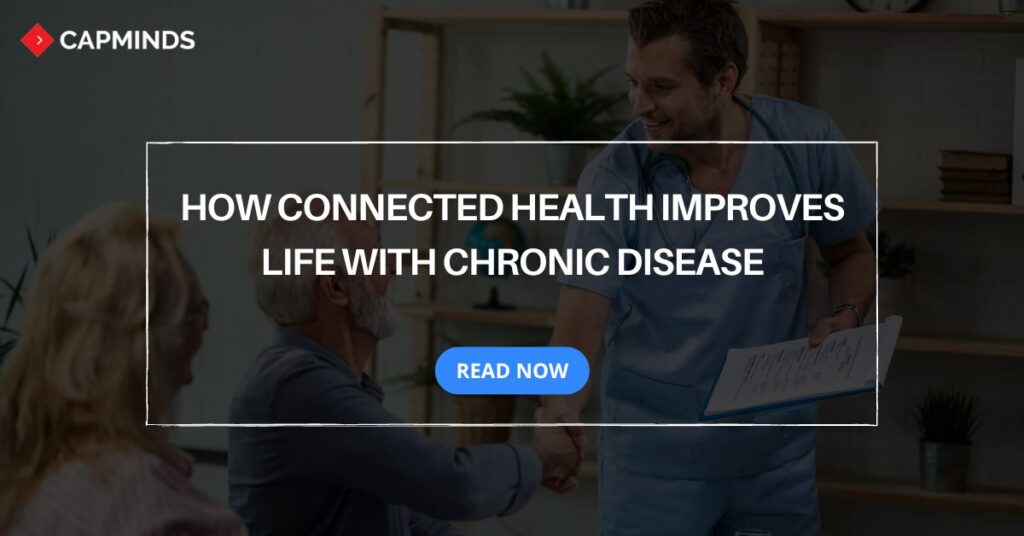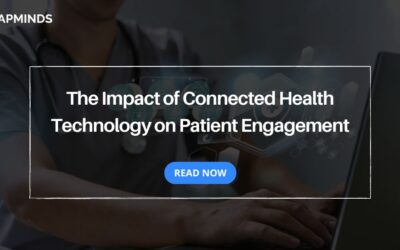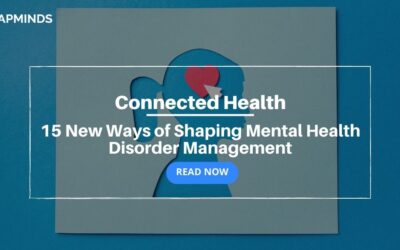How Connected Health Improves Life with Chronic Disease
According to statistics, around 6 out of 10 adult individuals have suffered from chronic diseases like kidney disease, heart disease, cancer, diabetes, and others in the United States. Chronic disease is a type of health condition that lasts for a year or more and requires ongoing treatment and care management.
Managing this health condition can be critical as it requires recurring check-ups and ongoing care. Due to the healthcare industry’s evolution, connected health evolves and transforms healthcare practice by changing the way healthcare is delivered, especially for chronic disease patients.
The adoption and implementation of connected health, including telehealth platforms and Remote patient monitoring devices, have gained popularity during the pandemic. This encouraged healthcare organizations to leverage connected health technology to enable services for betterment.
Connected health approaches for managing chronic diseases spread even as in-person care resumed. This blog will walk you through How Connected Health aids in managing chronic conditions efficiently.
What is Connected Health?
Connected Health is a healthcare management where various aspects of digital technology like Electronic Health Records, Remote Patient Monitoring Devices, Telehealth Solutions, and Others are linked together to provide healthcare for patients.
The Main Motive of Connected Health is to create a system where digital healthcare technologies are connected and empower providers to easily share information and communication to provide coordinative healthcare for patients. Here are a few connected health technologies you need to know of:
- Telehealth
- Remote Patient Monitoring
- Wearable Devices
- mHealth apps
- Electronic Health Records
- Personalized Medicine
- Health Information Exchange
Other healthcare technologies are connected to provide better quality healthcare to patients and empower them by providing up-to-date medical information. This will encourage them to make more informed decisions about their healthcare.
Related: Unlocking the Power of Connected Health Data: From Insights to Actionable Strategies
How Providers Address Chronic Disease Using Connected Health
By understanding the importance and popularity of connected healthcare wearable devices, healthcare organizations are adopting and implementing this technology to improve chronic disease management.
Case Study: a healthcare organization integrated with connected health technology comprised of practices that have leveraged wearable device technologies for chronic management programs.
The program aims to focus on managing chronic disease patients with kidney disease, diabetes, heart failure, and others. Preconfigured wearables that monitor their vital signs are given to the patients. The healthcare staff at the medical facility receives the data. This way providers can easily address chronic disease by analyzing the health vitals.
How Connected Health Supports Chronic Condition Management
Connected Health significantly supports patients with chronic conditions by providing them with remote patient monitoring tools that enable them to stay connected with their care providers.
1. Remote Patient Monitoring
RPM programs are an effective healthcare technology that helps chronic disease patients in so many ways. Remote patient monitoring is a telehealth technology that empowers patients to use medical devices to check their health vitals.
- When enrolled in a remote patient monitoring program, they use connected health devices such as blood pressure cuffs, scales, blood glucose monitors, and others to measure vital health signs conveniently.
- These devices are seamlessly connected to the provider’s healthcare system wirelessly to share the collected health data for review.
- Clinicians have access to chronic disease patients’ collected health vitals via electronic health records.
Here are three reasons for utilizing remote patient monitoring for chronic disease:
- It helps to earlier identify chronic diseases to promote precaution
- RPM helps to adjust treatment plans based on real-time health data
- Remote Patient Monitoring encourages patients to participate in their healthcare journey
2. Telehealth and Virtual Consultations
Telehealth gained popularity during the pandemic as most individuals prefer remote care instead of visiting the healthcare facility in person. This technology uses telecommunication channels like video conferencing, secure messaging, and phone calls with the providers for health consultations.
Usually, patients with chronic conditions are required to be monitored repeatedly. Chronic condition patients needed to travel to the healthcare practice for checkups and consultations.
Telehealth eliminates the need to visit the facility in person by allowing patients to connect with their care providers for virtual consultation.
- Utilizing telehealth for chronic health conditions, providers can ensure continuity of care for patients.
- Encourage providers to proactively monitor patient vitals and intervene as necessary to prevent precautions.
- Healthcare practitioners can adjust treatment plans based on changing health vital signs.
By utilizing telehealth and virtual consultation, chronic disease patients can avoid the need to recurringly travel to facilities and embrace virtual healthcare consultation for convenience.
Related: What are the Top 10 Connected Health Telehealth Use Cases in Mental Health
3. Mobile Health Apps and Wearables
With the urges of smartphones which have become a major part of daily life, healthcare applications become necessary. Many mobile health apps like Google Fit, TeleDoc, Heal, Apple Health, WebMD, and others help to monitor individuals’ health vitals.
From nutrition checks to tracking health vitals using built-in sensors, these healthcare applications aid patients with chronic diseases for efficient management.
In addition, wearable devices allow chronic disease patients to track vital health signs 24/7. Patients can wear a small health device that collects and transmits health data in real-time.
Wearable medical technology allows physicians to track, record, and evaluate patients’ acute or chronic conditions while they are away from a hospital or clinic. They allow the practitioner to understand the patient’s sickness situation in real-time and implement preventative clinical treatments.
- Remote Monitoring of Vital Signs and Symptoms
- Self-management tools (Medication reminders, education, and tracking)
- Continuous data collection on health parameters
- Improved treatment adherence through reminders and notifications
- Early detection of changes and complications
- Personalized care based on individual patient data
Overcoming Barriers to Connected Health Adoption
Even though connected health care like telehealth, remote patient monitoring, mobile health applications, and others help to manage chronic conditions significantly, it poses potential challenges.
For patients and providers, navigating these pitfalls is crucial for betterment. Here are the challenges associated with connected health for chronic disease management.
1. Privacy Concerns
Commonly, when it comes to digital solutions, privacy issues arise. Connected health often involves collecting, storing, and sharing patient-sensitive health data. Ensuring the privacy and security of this patient’s data is crucial to maintaining trust and complying with regulatory requirements.
Solution: Robust data protection measures such as data encryption, access control, and ensuring communication protocols must be implemented to mitigate data breaches and unauthorized access risks.
2. Technology Accessibility
Lack of technological accessibility to devices, reliable internet connections, or digital literacy has become a barrier for patients in leveraging connected healthcare technologies.
Solution: Work together with governmental organizations, nonprofits, and business associates to close the digital divide by delivering accessible and inexpensive gadgets, enhancing infrastructure in underserved areas, and providing thorough training courses.
3. Workflow Changes
It can be difficult and disruptive to integrate linked health technology into current healthcare workflows, which may result in opposition from healthcare practitioners and inefficiencies in the provision of care.
Solution: Understanding the requirements and pain areas of frontline staff, administrators, and healthcare providers promotes tight collaboration. Simplify data integration procedures to guarantee information flow between systems. Offer thorough training and support to enable seamless workflow transitions.
CapMinds Connected Health Solutions
Need cost-effective and reliable connected health solutions? CapMind’s Smart Connected Health Solutions make healthcare more accessible, convenient, and cost-effective.
CapMinds seamlessly integrates and implements cutting-edge connected health devices like Smart Meter, Google-Fit, Dexcom, Ambrosia, Freestyle Libre, Tidepool, etc. By leveraging CapMinds Smart Connected Health Solutions;
- Patients can effortlessly monitor their health’s vital signs.
- Stay connected with healthcare providers.
- Reduce the healthcare costs.
- Avoid healthcare practice readmissions.
- Enhance Medication Adherence.
- Prevent Complications
- Provide better care for patients conveniently
Choose CapMinds Smart Connected Health Solutions for a Smarter and Healthier Tomorrow.
Reach out to CapMinds and let us help you better connect for patient outcomes.




